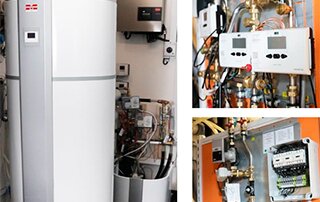Ultra-Low temperature district heating introduces multiple benefits at network level, as the reduction of heat losses and the improvement of heat generation efficiency. ULTDH also facilitates the integration of low temperatures renewable energy sources and waste heat into the district heating network. Renewable heat sources as solar thermal and heat pumps can be coupled to the district heating network and the buildings through specially designed district heating substations.

Some images of the Microbooster and BILTST demonstration in Taastrup, Denmark.
During the development of the RELaTED project, several Triple Function Substations (3FS) have been evaluated and designed. Those were investigated in different versions, connection schemes configurations and operating modes depending on the district heating characteristics, the building types and the heating technologies used.
This includes the design of Triple Function Substations (3FS) in combination with different RELaTED technologies:
- Building Integrated Low-Temperature Solar Thermal system (BILTST).
- District Heating Reversible Heat Pump (DHRHP).
- Microbooster Heat Pump.
During the development of the project it was found that there is not such a single 3FS substation design, but that the unit main design characteristics depends not only on the load levels but also on the type of DH networks and the type of heating system the 3FS is placed in. The possible concept designs of the 3FS were grouped in the following case scenario:
During the development of the RELaTED project, several Triple Function Substations (3FS) have been investigated in different versions, connection schemes configurations and operating mode.
ULTDH connected to:
- Existing buildings with:
- DHRHP and BILTST (Demo in Taastrup (DK)
- DHRHP (Demonstration in Taastrup (DK)
- nZEB buildings with:
- DHW Microboosters and BILTST (Demonstration in Taastrup (DK)
- DHW Microboosters alone (Demonstration in Taastrup (DK)
LTDH connected to:
- Existing buildings:
- With BILTST (Demonstration in Belgrade)
- Without BILTST (Standard case)
System and flow diagrams for each case were proposed. In the case of a 3FS for ULTDH connected to existing buildings equipped with BILTST, a maximum of eleven possible theoretical combined operational modes were found. In this specific case a more detailed Process and Instrumentation Diagram (P&ID) was initially proposed.
Demo sites
Belgrade (Serbia). The demand specification of a Two-Function Substation (2FS) specifically adapted for the Belgrade primary school demonstration site was prepared. Control strategy and process diagrams were developed and a mechanical design was proposed. The unit is being currently built and it is expected to enter in operation before the end of Q3 2021.
Taastrup (Denmark). The demand specification for three different district heating substations was prepared. This includes process and instrumentation diagrams, flow chart, control specifications, bill of materials and mechanical design. All units were installed in Taastrup, and they are operating on the same heating grid but on alternative applications.
Download the complete document >>
